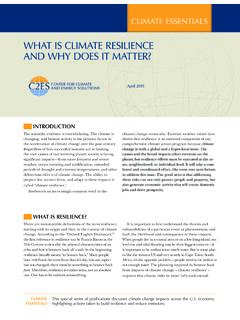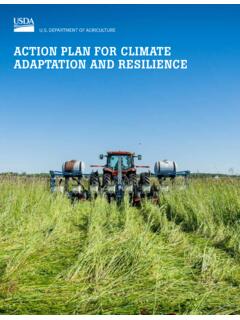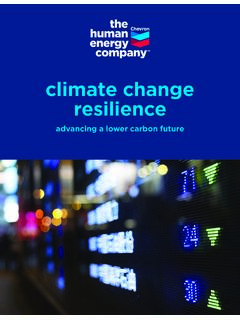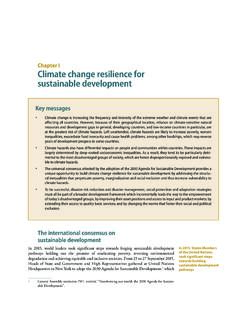Transcription of Urban Climate Change Resilience: A Synopsis
1 Urban . Climate . Change . resilience . A Synopsis 2014 Asian Development Bank All rights reserved. Published in 2014. Printed in the Philippines. Publication Stock No. ARM146551. The views expressed in this publication are those of the authors and do not necessarily re ect the views and policies of the Asian Development Bank (ADB) or its Board of Governors or the governments they represent. Note: In this publication, $ refers to US dollars. 6 ADB Avenue, Mandaluyong City 1550 Metro Manila, Philippines Tel +63 2 632 4444. Fax +63 2 636 2444. For orders, please contact: Public Information Center Fax +63 2 636 2584.
2 Printed on recycled paper Contents 1 Introduction 4. 2 Core Principles and Qualities 6. 3 Planning for resilience 9. 4 Knowledge 14. 5 Investments and Projects 17. 6 Further Reading 26. 1. Introduction Cities across the globe, particularly those with Urban poor communities, face long-term challenges in ensuring the well- being of their inhabitants. These challenges are partly a result of direct and indirect impacts of Climate Change , and are often compounded by preexisting vulnerability. Urban resilience is the capacity of cities to function, so that the people living and working in cities particularly the poor and vulnerable survive and thrive no matter what stresses or shocks they encounter.
3 Urban Climate Change resilience Maintaining essential Urban functions The concept of resilience has been useful in addressing Climate Actions to build resilience should respond to three risk and unexpected events, and in enhancing efforts to survive key questions: and thrive in the context of Climate 1. How does the city work (the Urban systems)? 2. What are the direct and indirect impacts of Climate Urban Climate Change resilience (UCCR) embraces Climate Change ( Climate Change )? Change adaptation, mitigation actions, and disaster risk 3. Who is least able to respond to shocks and stresses reduction while recognizing the complexity of rapidly growing (vulnerable groups)?
4 Urban areas and the uncertainty associated with Climate Change . This approach places greater emphasis on considering Figure 1 highlights that the action focusing on disaster risk cities as dynamic systems capable of evolving and adapting to reduction and/or Urban poverty reduction is necessary survive and even thrive in the face of volatile shocks or stresses. but insufficient to maintain Urban functions in the face of direct and indirect Climate Change impacts. Urban resilience to Climate Change describes a city that is resilient on three levels: 1. y the systems of the city survives shocks and stresses; 1 How does the y the people and organizations are able to accommodate these city work?
5 Stresses into their day-to-day decisions; and Urban Urban 2 Who is least able Urban . y that the city's institutional structures continue to support the poverty SYSTEMS. Climate risk to respond to shocks reduction management capacity of people and organizations to ful l their aims. and stresses? 3 What are the direct There is no single action that will make a city resilient to Climate Climate and indirect impacts VULNERABLE. E. Change of Climate Change ? Change . resilience is instead achieved through a number of GROUPS. actions, building upon each other over time. These actions Direct impact 3.
6 Disaster 2. would be enhanced and progressed as peoples and institutions Indirect impact risk learn from past experiences and apply it to future decisions. reduction Figure 1: Conceptualizing Urban resilience to Climate Change Source: Da Silva, et al. 2012. 1. Asian Cities Climate Change resilience Network. 2013. ACCCRN City Projects. Introduction 5. As detailed in Section 2 (page 3) of this Synopsis , building UCCR is founded on the following principles and qualities that Purpose of this Synopsis must be integrated into any effort to advance action: What is it for? To provide a concise introduction to Urban y Principles: combining hard and soft measures, engaging diverse Climate Change resilience , including the core concepts perspectives through multistakeholder processes, engaging and principles, relevant processes, experiences from different geographic and governance scales, addressing implementation, and outcomes sought from a UCCR- today's problems while embedding a long-term vision, tapping based approach.
7 Into local expertise, building leadership and local action, and focusing on vulnerable communities Who is it for? For ADB project officers, consultants, and y Qualities: re ective, robust, redundant, exible, resourceful, partners who are interested in UCCR. It explains how inclusive, and integrated UCCR is understood in the context of Urban Climate Change resilience Trust Fund, managed by ADB. Why second-tier cities? Why is it necessary? To communicate the principles, processes, and practices associated with UCCR in a Residents of second-tier cities have very different levels of succinct and accessible way.
8 UCCR is a relatively new access to services. This differentiation is a product of rapid approach to addressing the uncertainty that Climate increase in Urban population and demand for services, a lack of Change and rapid urbanization bring to cities. funding, inadequate planning, and preexisting patterns of social Large sections of the Urban population lack economic power and political voice, and an increasing number of people are living in slums. De nitions At the same time, these cities will still be making signi cant Climate Change Mitigation: actions to reduce emission of decisions on planning, land-use, and major investment projects.
9 Greenhouse gasses. Intergovernmental Panel on Climate It is during these decisions that the interactions between Change (IPCC). Climate Change and Urban development can be effectively addressed. This type of decision making will assist in managing Climate Change Adaptation: adjustment in natural or the challenges of current development whilst also considering human systems in response to actual or expected climatic the future scenarios of Climate Change . stimuli or their effects, which moderates harm or exploits bene cial opportunities. (IPCC). Who (and what) is most at risk?
10 Urban Climate Change resilience : capacity of cities to function, so that the people living and working in cities . Urban areas that are most susceptible to external shocks particularly the poor and vulnerable survive and thrive in and stresses (including Climate Change ) are those that have the face of shocks and stresses related to Climate Change . fragile systems as well as large populations of the socially or economically marginalized. These impacts are most felt by vulnerable people as a result of their high exposure to hazards, or a lower ability to adapt and respond (due to physical Indirect impacts on Urban areas resulting from these shocks limitations or nancial capacity).















